The AMD Zen and Ryzen 7 Review: A Deep Dive on 1800X, 1700X and 1700
by Ian Cutress on March 2, 2017 9:00 AM ESTBenchmarking Performance: CPU System Tests
Our first set of tests is our general system tests. These set of tests are meant to emulate more about what people usually do on a system, like opening large files or processing small stacks of data. This is a bit different to our office testing, which uses more industry standard benchmarks, and a few of the benchmarks here are relatively new and different.
PDF Opening
First up is a self-penned test using a monstrous PDF we once received in advance of attending an event. While the PDF was only a single page, it had so many high-quality layers embedded it was taking north of 15 seconds to open and to gain control on the mid-range notebook I was using at the time. This put it as a great candidate for our 'let's open an obnoxious PDF' test. Here we use Adobe Reader DC, and disable all the update functionality within. The benchmark sets the screen to 1080p, opens the PDF to in fit-to-screen mode, and measures the time from sending the command to open the PDF until it is fully displayed and the user can take control of the software again. The test is repeated ten times, and the average time taken. Results are in milliseconds.
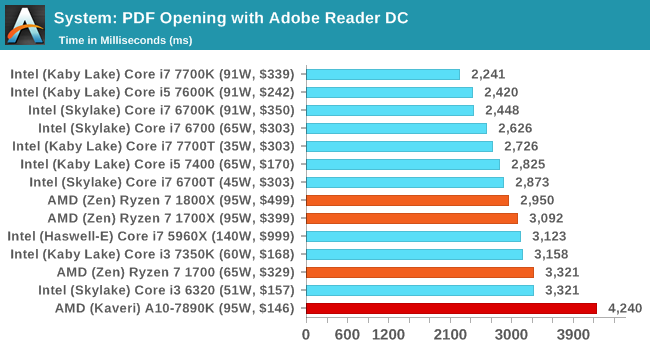
FCAT Processing
One of the more interesting workloads that has crossed our desks in recent quarters is FCAT - the tool we use to measure stuttering in gaming due to dropped or runt frames. The FCAT process requires enabling a color-based overlay onto a game, recording the gameplay, and then parsing the video file through the analysis software. The software is mostly single-threaded, however because the video is basically in a raw format, the file size is large and requires moving a lot of data around. For our test, we take a 90-second clip of the Rise of the Tomb Raider benchmark running on a GTX 980 Ti at 1440p, which comes in around 21 GB, and measure the time it takes to process through the visual analysis tool.
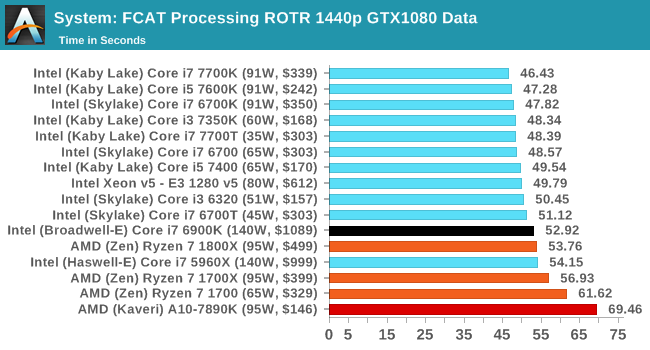
3D Particle Movement v2.1
This is the latest version of the self-penned 3DPM benchmark. The goal of 3DPM is to simulate semi-optimized scientific algorithms taken directly from my doctorate thesis. Version 2.1 improves over 2.0 by passing the main particle structs by reference rather than by value, and decreasing the amount of double->float->double recasts the compiler was adding in. It affords a ~25% speed-up over v2.0, which means new data.
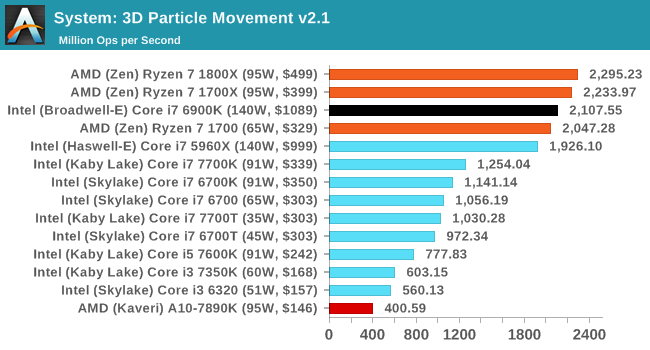
DigiCortex 1.16
Despite being a couple of years old, the DigiCortex software is a pet project for the visualization of neuron and synapse activity in the brain. The software comes with a variety of benchmark modes, and we take the small benchmark which runs a 32k neuron/1.8B synapse simulation. The results on the output are given as a fraction of whether the system can simulate in real-time, so anything above a value of one is suitable for real-time work. The benchmark offers a 'no firing synapse' mode, which in essence detects DRAM and bus speed, however we take the firing mode which adds CPU work with every firing.
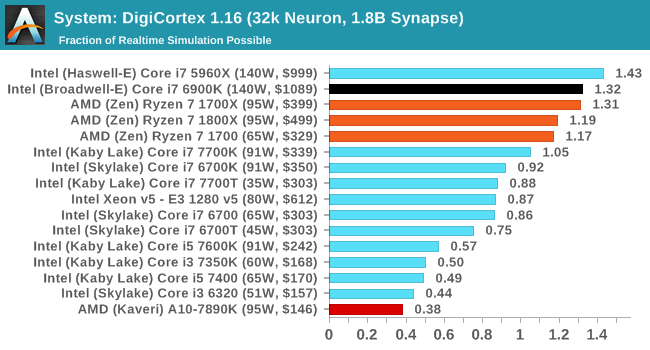
Agisoft Photoscan 1.0
Photoscan stays in our benchmark suite from the previous version, however now we are running on Windows 10 so features such as Speed Shift on the latest processors come into play. The concept of Photoscan is translating many 2D images into a 3D model - so the more detailed the images, and the more you have, the better the model. The algorithm has four stages, some single threaded and some multi-threaded, along with some cache/memory dependency in there as well. For some of the more variable threaded workload, features such as Speed Shift and XFR will be able to take advantage of CPU stalls or downtime, giving sizeable speedups on newer microarchitectures.

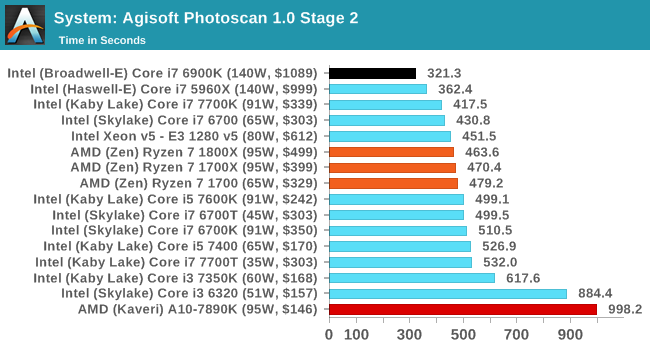
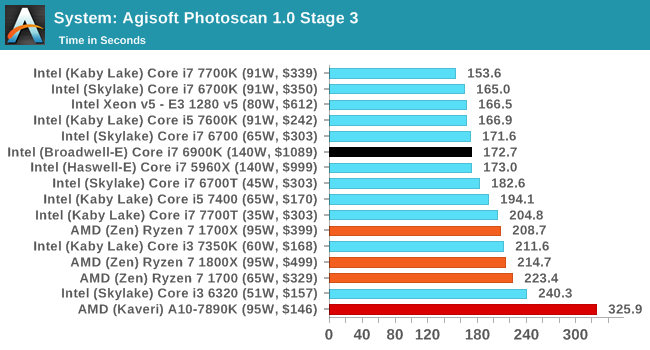
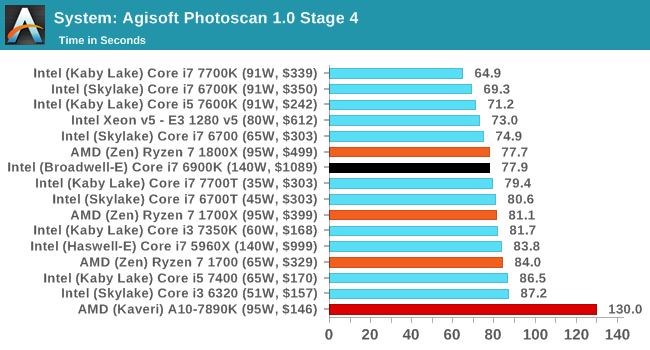
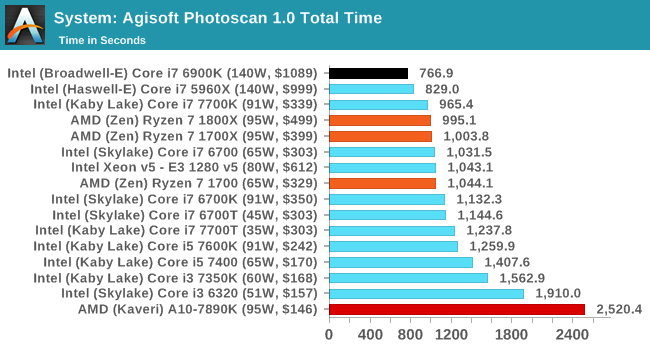










574 Comments
View All Comments
Crono - Thursday, March 2, 2017 - link
A Hero Has RyzenSweeprshill - Thursday, March 2, 2017 - link
Lived up to the hype. Ryzen is a beast. Intel needs massive price cuts on their 2011-v3 chips. Well done AMD, best price/performance CPUs on the market and as fast or faster than Intel performance.sans - Thursday, March 2, 2017 - link
Hey, what you have found which features improving on AMD's crap has been found in Intel's products for years.Nem35 - Thursday, March 2, 2017 - link
Yeah, and it's beating the Intel. Funny, right?Sweeprshill - Thursday, March 2, 2017 - link
Yeah these new AMD chips are monsters. Wondering how large the price cuts are that Intel will bring to their 2011-v3 chips to compete.czerro - Friday, March 3, 2017 - link
Intel already slashed prices pretty drastically 4 days ago, to kinda deflate Ryzen's release. Before price cuts, Ryzen had a huge price and performance advantage at all metrics, and Intel would have looked ridiculous.I can't believe people aren't reporting the price-cutting right before Ryzen release more. Intel only did it to save face on graphs and confuse people. Ryzen definitely had Intel by the balls a week ago before the price cuts.
It's great that we all have options now, but this really smeared Ryzen's release in a cheap way that anybody can point out all those Intel chips were 100-200 dollars more expensive less than a WEEK ago.
SodaAnt - Saturday, March 4, 2017 - link
No, Intel hasn't slashed prices. There was a sale at microcenter a few days back, but there's no across the board official price cut on Intel chips.Notmyusualid - Monday, March 6, 2017 - link
@ SodaAntAgreed, I see no Intel price drops either.
Notmyusualid - Friday, March 3, 2017 - link
@ Nem35Incomplete review.
After seeing a gaming-focused review, I'd say the AMD procs are just OK. I welcome AMD is back with a fighting chance, but about half my purchase choice will be game-inspired.
Quote:
"For gaming, it’s a hard pass. We absolutely do not recommend the 1800X for gaming-focused users or builds, given i5-level performance at two times the price."
I'm not a 'fanboi', as I'd have no trouble fitting a 1700X in a build I wouldn't game in. But otherwise, like another reviewer said, its a hard pass.
Alexvrb - Saturday, March 4, 2017 - link
For gaming builds the upcoming Ryzen 5 and 3 series will offer a lot more bang for your buck and will compete much more aggressively. However, the Ryzen 7 still offers decent gaming performance and excellent performance everywhere else. The gobs of cores may come in handy in the future too, even in games - as more threads will be available on more rigs, devs will take notice. This year AMD is definitely lowering the pricing for 8-16 thread processors, clearing a path for the future of gaming.With that being said I still think that when strictly considering gaming, their Ryzen 3/5 quadcore models will be a far better value, especially as current-gen games aren't often built in such a way that they can take advantage of the Ryzen 7.